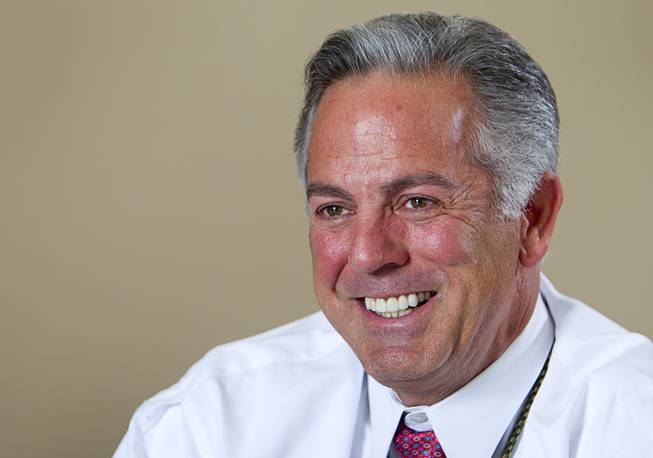
Clark County Sheriff Joe Lombardo smiles during a meeting with Las Vegas Sun reporters and editors at Metro Police headquarters Tuesday, March 24, 2015.
Wednesday, March 25, 2015 | 2 a.m.
Las Vegas’ new sheriff has forged ahead since taking office in January, pushing a vision that drastically shifts course from the days of his mentor and predecessor.
“I don’t want people to think I’m in a honeymoon period,” Joe Lombardo said during an editorial board meeting with the Sun on Tuesday.
Lombardo has wasted little time in his early days as Metro’s top cop. Here are some early accomplishments and goals:
He has begun to redistribute the agency’s resources.
With a vision to bring employees closer to the areas they serve, Lombardo wants to funnel resources into the department’s neighborhood substations. By contrast, his predecessor, Doug Gillespie, worked to consolidate the department and oversaw the purchase of a $200 million, three-building home base downtown. Lombardo is reshuffling the department’s ranks and moving about 130 detectives — less than 3 percent of Metro’s workforce — out of the agency’s headquarters.
He’s also reopening shuttered reception areas at half of Metro’s eight neighborhood substations. Citing budget cutbacks, Gillespie began closing those lobbies in 2010, which limited access for people submitting police reports in person.
To reopen those buildings to the public, Lombardo has budgeted money to hire 14 civilians. Reception desks at the following substations should open in the next fiscal year:
• Bolden Area Command, 1851 Stella Lake Street
• Downtown Area Command, 621 North 9th Street
• South Central Area Command, 4860 Las Vegas Boulevard South
• Southeast Area Command, 3675 East Harmon Avenue
He has sought funding for more body cameras.
Metro is in the middle of a $1.6 million pilot program researching the effectiveness of body cameras using 197 of the devices worn by volunteer officers. The yearlong study began in November.
Lombardo, a proponent of the technology, says he wants to equip 436 more patrol officers. Funding could be approved as early as April, and the agency could start buying new cameras by July.
“The public demands us to be more accountable and transparent, and part of that demand is body cameras,” Lombardo said. “I’m in absolute support of that.”
The gadgets made headlines last week after camera footage unearthed an alleged case of excessive force by Officer Richard Scavone. On the other hand, Metro said video footage from the cameras has exonerated officers accused of improper behavior by residents.
He wants Metro to respond to more non-injury wrecks
Lombardo says he hopes the department can eventually begin responding to all non-injury wrecks if it can get enough funding for more officers.
Lombardo, who last year played a key part in overseeing the unpopular implementation of Metro’s policy to stop responding to minor vehicle crashes, admitted that the transition was handled too abruptly. Metro still responds to some non-injury accidents, including those involving a hit-and-run driver or a disabled vehicle.
“We did a poor job,” Lombardo said. “I apologize for that. I take responsibility for that.”
Still, the change has helped Metro refocus its efforts on enforcement, Lombardo said, and that has led to an 18 percent drop in fatal wrecks since the new policy was enacted.
He has gotten enough funding to hire 55 new officers
To carry out most of the sheriff’s goals, he’ll have to tackle the department’s biggest and most complicated challenge: obtaining more funding.
Lombardo is trying to find ways to bolster Metro’s $520 million budget, which comes from a mix of property taxes, sales taxes and funding from Clark County and Las Vegas.
So far, he’s been able to get enough money next year for 55 officer positions, bringing the department’s cop-per-resident ratio up slightly to 1.74.
He has a long way to go: Lombardo wants to hire at least 350 more to bring Metro more closely in line with the national average of 2.4 officers per 1,000 residents.

Join the Discussion:
Check this out for a full explanation of our conversion to the LiveFyre commenting system and instructions on how to sign up for an account.
Full comments policy